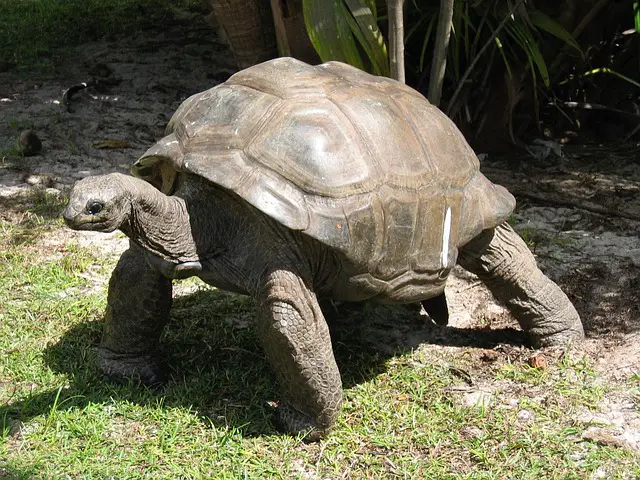Tortoises are often considered one of the cutest animals in the world. Their adorable appearance and gentle demeanor have made them a popular pet choice for many people. But what exactly makes tortoises so cute?
One reason for their cuteness is their unique physical features. Tortoises have round, dome-shaped shell, and wrinkled, friendly face that gives them a distinctively cute look.
Their short legs and slow movements also add to their charm, making them seem like gentle giants.
Another reason why tortoises are so cute is their personality. They are known for being calm, docile, and friendly creatures that enjoy being around people.
Their gentle nature and slow pace make them perfect pets for those looking for a low-maintenance companion.
Overall, there are many reasons why tortoises are considered one of the cutest animals in the world, and their popularity as pets is a testament to their charm and appeal.
Physical Characteristics
Shell
Tortoises are known for their unique and adorable physical characteristics. One of the most distinctive features of tortoises is their shell, which comprises two parts: the upper part (dome-shaped carapace) and the lower part (flat plastron).
The shell comprises bony plates covered with keratin, the same material found in human nails and hair.
The color and pattern of the shell can vary depending on the tortoise species. Some have a plain brown or black shell, while others have intricate patterns of spots or stripes.
The shell protects from predators and helps regulate the tortoise’s body temperature.
Legs
Another characteristic that makes tortoises so cute is their short, stubby legs. Tortoises have four legs with sharp claws that help them dig into the ground and climb over obstacles.
Despite their slow-moving nature, tortoises are surprisingly agile and can move quickly when needed.
Feet
Tortoises have large, scaly feet with thick skin that protects them from rough terrain. The feet are designed for walking on land and are unsuitable for swimming.
The toes on the feet are short and stubby, and the tortoise’s weight is distributed evenly across the feet to help support its heavy shell.
In conclusion, the physical characteristics of tortoises, including their shell, legs, and feet, make them cute and fascinating creatures.
Their unique adaptations have helped them survive millions of years and continue captivating people of all ages.
Behavior and Habitat
Diet
Tortoises are herbivores, meaning they eat only plant matter. They have a slow metabolism, which allows them to extract as much nutrition as possible from their food.
Tortoises’ diets vary depending on their species and habitat, but most eat a combination of grasses, leaves, fruits, and flowers.
Some tortoises, like the Galapagos tortoise, can go without food or water for months, surviving on stored nutrients and moisture.
Habitat
Tortoises are found on every continent except Antarctica. They live in various habitats, including deserts, grasslands, forests, and wetlands. Tortoises are adapted to their environments and have unique physical and behavioral characteristics that help them survive.
For example, desert tortoises have thick, scaly skin that helps them retain moisture and dig burrows to escape the heat.
Tortoises are also known for their longevity. Some species can live for more than 100 years. This is partly due to their slow metabolism and low activity levels, which reduces wear and tear on their bodies. Tortoises are also resilient and can survive in harsh conditions.
In conclusion, tortoises’ diet and habitat are closely linked to their survival and well-being. Their herbivorous diet and environmental adaptations help them thrive in various habitats worldwide.
Conservation Status
Tortoises are widely recognized as cute and charming creatures. However, many species of tortoises are facing threats to their survival.
Habitat loss, hunting, and the illegal pet trade are significant factors contributing to the decline of tortoise populations.
According to the International Union for Conservation of Nature (IUCN), almost half of the world’s tortoise species are threatened with extinction.
The organization has listed more than 100 species of tortoises as endangered, critically endangered, or vulnerable.
One of the most endangered tortoise species is the ploughshare tortoise, native to Madagascar. The ploughshare tortoise is considered one of the rarest tortoises in the world, with only a few hundred individuals remaining in the wild.
The species is threatened by habitat loss due to mining, agriculture, logging, hunting for its meat, and the illegal pet trade.
Another threatened species is the radiated tortoise, also native to Madagascar. The radiated tortoise is highly valued for its beautiful shell, making it a poacher target.
The species has experienced a population decline of over 80% in the last 30 years, and it is now listed as critically endangered by the IUCN.
Conservation efforts are being made to protect tortoise populations and their habitats. Some of the measures include creating protected areas, enforcing laws against hunting and the illegal pet trade, and educating local communities about the importance of conservation.
However, more needs to be done to ensure the survival of these beloved creatures.




